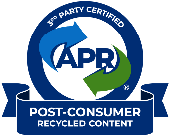Plastic Lifecycle
From the 1930s to the future of plastic, learn how an innovation created for wartime became a household item and how our goal is to make it a more renewable resource.
The 1930s
Global plastic demand: <1 M TONS/YR
Recycling Rate: 0.0%
In the 1930s, plastic began as a wartime innovation, with an original intent to be a lighter, safer, better production material. While nylon was repurposed for military applications, HDPE (High Density Polyethylene) was used to improve performance and reduce cost and waste and was held as a state secret. The invention of plastic made society more sustainable in the short term.

The 1950s
Global plastic demand: 2.2 M TONS/YR
Recycling Rate: 0.0%
The 1950s saw an exponential growth of plastics. Polyester first reached the market and was hailed as a wonder fiber. You could wash a garment, hang it up, and have it ready to wear in a couple of hours with no need for ironing. Plastic packaging begins to replace traditional packaging due to its economical, convenient, and environmentally friendly attributes. Single-use and disposal were not initially the primary concerns about plastics.

The 1980s
Global plastic demand: 6.8 M TONS/YR
Recycling Rate: 0.3%
As we begin running out of landfill space for plastic waste, the nation begins to shift its focus to recycling. Along with this new focus comes the creation of Resin Identification Codes. However, as plastics become universal and the production costs continue to go down, not as much thought is given to end-of-life processing or creating secondary applications for discarded plastics.

The 1990s
Global plastic demand: 17.1 M TONS/YR
Recycling Rate: 7.9%
In the 1990s, we began to see a collective interest in plastics recycling. However, just as we started to solve the single-use bottle issue, the range of plastics in use broadened. This created investments in a wider range of plastics and a continued growth of the plastics market. As a result, the recycling rate moved in a linear fashion after an exponential jump.

Early 2000s
Global Plastic Demand: 35.6 M TONS/YR
Recycling Rate: 8.7%
In the early 2000s, recycling challenges arise. China stopped accepting mixed plastics for disposal, resins are combined, and only limited markets exist for grey and black resin. Single-stream recycling was put in place to help make life easier for the consumer, but contamination remains an issue. Demand for recycling solutions continued, but limited dollars are available to solve the challenges.

The Future of Plastic
Fossil-based plastic production declines
PureCycle emerges as a global recycling solution
The versatility of polypropylene plastic combined with PureCycle’s technology leads to the next evolution of plastics recycling. It will take all of us to increase recycling rates, but innovation will drive us toward a circular economy. PureCycle’s ultra-pure recycled resin with its clarity and low odor can be offered as a replacement for virgin polypropylene. The future of plastic waste is clear.

See how we are impacting the recycling game.
Learn more about who we are here at PureCycle, and the game-changing polypropylene recycling technology that PureCycle uses.






